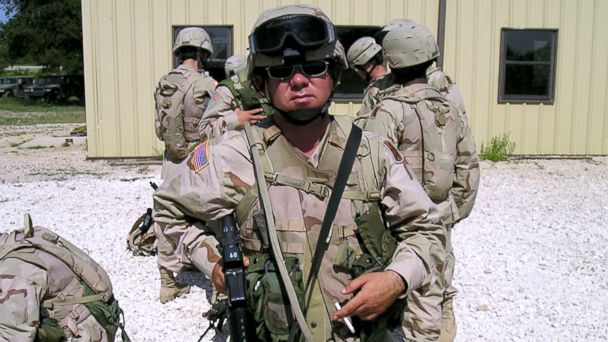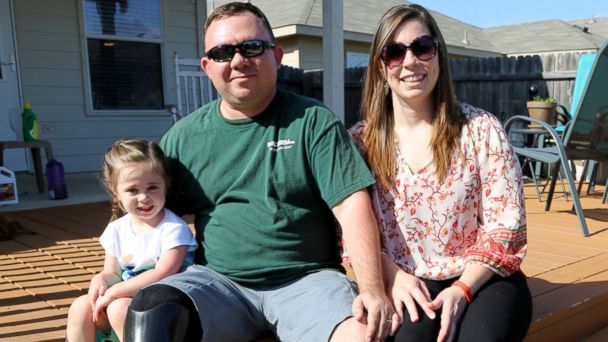U.S. Army Veteran Turns Injury Into Innovative Startup
U.S. Army Sgt. Gary Walters joined the Louisiana Army National Guard in 1996 as a way to help pay for college. He comes from a long line of military service in the family. "I always wanted to be in the military but going active duty wasn't really what I wanted to do at first," he says.Walters planned to serve for one enlistment and go to college but instead he ended up serving for 6 ½ years. He served a cavalry scout, engaging the enemy in the field. "The closest friends I ever made came from the Army. I built lifelong friendships," he says.

U.S. Army Sgt Gary Walters. Gary Walters
Walters re-enlisted after 9/11 and was deployed to Iraq. Early on Jan. 10, 2005 Walter's unit rolled out to support another unit under heavy fire. As they were scouting the area, their Bradley Fighting vehicle was hit by an IED. "It sounded like a large bomb. I was knocked unconscious for a few seconds. Woke up and the video was engulfed in flames," he says. The IED exploded right through the fuel tank of the vehicle. "I got my arms on two of friend's shoulders and we start walking and after five steps I started yelling because my leg was broken," he says.

Gary Walters in his hospital bed with a Purple Heart medal. Gary Walters
Rehabilitation for Walters was a long process. He spent 2 ½ years recovering. "When I was first injured I had severe burns over my lower right leg and several of the bones in my foot had been crushed. My doctor didn't want to amputate and we tried different surgeries but due to the amount of scar tissue and the burns it wasn't working out," he says. After a year and nine months Walter says he had enough and had them amputate his leg. He was provided with a prosthesis. "After that, things were great. It was a matter of learning how to walk which took six weeks to be up on my leg," he adds. Walter medically retired from the U.S. Army in June 2007. He found out retirement life in his 30's was not an option for him. That's when he enrolled at the University of Texas at San Antonio and started his working on his engineering degree. The engineering degree at UTSA leads to capstone project and he suggested the team to tackle the problem of prosthesis cooling.

U.S. Army Vet Gary Walters inside a Bradley Fighting vehicle. Gary Walters
During his time at UTSA in San Antonio, Walters complained about heating in his prosthesis. "When I first got my prosthetic within days I went back to the prosthetist and asked him, what can do we do to solve the problem of heating and sweating because it is hot?" The response he got was pretty much to put on deodorant, but Walters wasn't satisfied with that. So he asked his professors about creating a cooling system for prosthetics.

Members of the Leto Solutions team gather outside their offices. Back row: Jake Montez, David Schultz, Justin Stultz. Front row: Becky Ariana, Gary Walters. Angel Canales/ABC News
Walters, along with his school mate David Schultz, currently Leto Solutions Manager, came up with the idea. They formed a senior design group and came together to create a solution. "Gary introduced this as a problem and we were there as the solution. He said he had a problem with heating and sweating in his leg," Schultz says. That's when a team of eight student came together to work on a solution to Walters' problem. Four engineering students including Walters, and four business students teamed up to build a prototype and a business plan. Leto Solutions Inc. had its origins in the University of Texas San Antonio and was formed in September 2013.

The Aquilonix Prosthesis Cooling System Prototype. Leto Solutions
Over the course of two semesters at UTSA, they developed The Aquilonix Prosthesis Cooling System designed to enhance the comfort of the prosthesis and promote healthy tissue. It is a unique, innovative system that thermoelectrically cools and dissipates heat from the area between the residual limb and prosthetic socket, maintaining a cool and dry environment. Becky Ariana, Leto Solutions president, was asked to be the students' mentor at the time. "My very first meeting was with Gary who was an engineering student and the inspiration behind the product. It is incredibly important that we have a member of our team who is an amputee because we see on a daily basis how important our product is. It creates urgency in all of us," Ariana says.
Their Engineering Capstone project won first place in the $100,000 Student Technology Venture Competition sponsored by the university's Center for Innovation and Technology Entrepreneurship. Leto Solutions hopes to have the Aquilonix Prosthesis Cooling System ready for the market before the end of 2014.
Being part of this venture has been one of the most rewarding things Walters says he's ever done. "This has afforded me a unique opportunity to that most people don't get in their lives. I've been part of the founding of a company and I'm also going to be able to provide financial support for my wife and child and at the same time I get to help other people while I do that," says Walters.

Eleanor, Gary and Kate Walters enjoy some quality family time in their backyard on a bright sunny Texas afternoon. Angel Canales/ABC News
Walters used to stop playing outdoors with his daughter Eleanor and now he enjoys spending more time with her. "The first time I went to the park wearing the prototype and I got to play uninterrupted with my daughter is not a felling I can verbalize. It was the most rewarding thing I've done in my life."
Second Tour is an ABC News digital series profiling the lives of military veterans who are doing unique things in the civilian world. For more stories, click here.
ABC News video editor Arthur Niemynski contributed to this report.